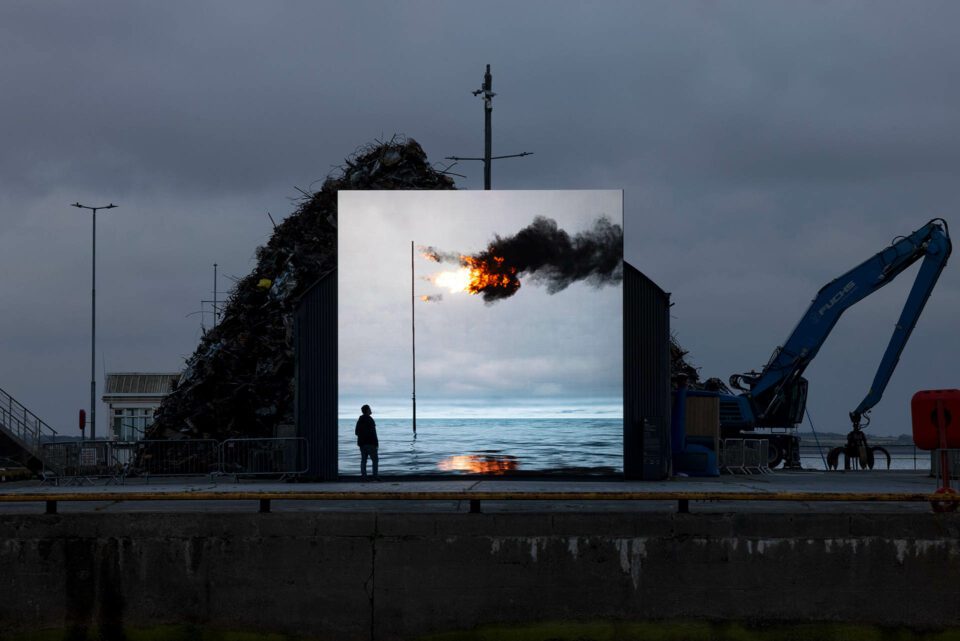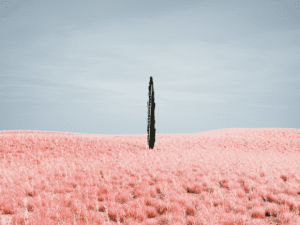When John Gerrard (b. 1974) was a child, he noticed earthworms floating in puddles of water across a field, near his home, in the idyllic countryside of County Tipperary, Ireland. “I remember being perplexed and saddened by it,” Gerrard, who is now 49 years old, says. “It was obviously strange that these worms were all dead.” They had died because of excessive pesticide and toxic farming practices, which posed a threat to the insects, animals, flowers and plants in the surrounding ecosystem, a place Gerrard and his family called home. “There’d been an over-usage of toxins within the landscape,” Gerrard recalls. Earthworms don’t technically qualify as pests, but were victim to chemicals in the soil. “That relationship – between what’s called progress and development, and is actually death – was definitely part of my childhood.”
Today, he works as a multidisciplinary artist using game engine- based technology to build highly-aesthetic, attentiongrabbing simulations, which mesmerise viewers. They offer virtual, yet hauntingly realistic, worlds that remind us of the impending dread of climate change, and how toxic emissions pose permanent damage to the future viability of habitats on planet Earth, and the numerous species who live upon it.
According to the National Oceanic and Atmospheric Administration, 91 percent of excess heat energy from greenhouse gases is trapped in the ocean, putting coastal populations at risk of natural disasters like cyclones and tsunamis. It’s also caused the bleaching of coral reefs, compromised marine breeding grounds and altered migration patterns of fish like salmon and sharks. Global oil demand has risen to 102 million barrels per day, according to recent figures from the International Energy Agency. China is behind most of this growth, with a record high of 17.1 millions of barrels per day in September. By 2050, nearly 10 billion people will exist on Earth, raising humanity’s carbon footprint and asking the pivotal question of how finite resources, like fossil fuels, will be distributed and consumed. Meanwhile, the oil industry raked in $144.58 billion in the third quarter of 2023 (NRDC), despite consumers being burdened with the crippling weight of oil prices, which have spiked as countries continue to experience the worst inflation rates in recent memory.

Gerrard’s fixation on the environment stems from his upbringing in Tipperary and seeing how his verdant, peaceful hometown changed over time. This developed a consciousness that shapes most of his politically oriented artworks today. “My mother was an environmentalist and ecologist, so we had a lot of discussions about agriculture and the systems we were surrounded with in the countryside,” Gerrard says. “If farmers sprayed on the wrong day, we would see the effects in our garden. She was very interested in humans and their usage of the landscape, which informed my practice.”
The result is Gerrard’s iconic triptych of emissions-based flags, which function as an alarm for global warming. Now, one of them, Flare, is on display at the National Gallery of Victoria Triennial in Melbourne, Australia. It’s a major event that exhibits artworks from 100 artists across four levels of the spacious, Jazz-era building. This year’s theme is Magic, Matter, and Memory, and those exhibiting include trailblazer Tracey Emin; performance artist Yoko Ono; Iranian painter Farrokh Mahdavi; the Parisian fashion house Schiaparelli;multidisciplinary Indigenous artist Betty Muffler; Dutch designer Iris van Herpen and the Italian sculptor Diego Cibelli.
Whilst Gerrard’s artwork is confined inside NGV’s walls, the artist’s virtual worlds tend to appear on massive LED panels in public spaces. Here, they catch the attention of regular passersby, and potentially inspire them to political action. “As an artist, I’m working in the public domain, so I often choose worlds that are placed on the street. In that setting, you will reach members of the public who would feel less comfortable entering a museum. I’m motivated to work out on the street in order to collide with unexpecting publics.”

The Irish artist’s breathtaking simulations have appeared in spaces and events that range from the mundane to the disruptive, the aesthetically-centered to the politically-charged, using eye-catching LED walls to provoke questions about the climate crisis. Gerrard’s immersive Surrender (2023) glimmered in the background of a U2 concert as the activist- friendly band staged their first live performance in four years in a stadium teeming with thousands. The haunting Flare (Oceania) (2021) appeared at the COP26 UN Climate Change Conference in Glasgow, in which a pact was drawn to reduce coal usage worldwide. In September 2020, Mirror Pavilion, Corn Work, a cube-shaped LED simulation depicting Irish folk figures known as the straw boys, and with three reflective sides mirroring local citizens, perched on the edge of a pier in front of a river in Galway, Ireland. The waterway once offered clean renewable energy before the rise of fossil fuels. Similarly, Gerrard’s ominous Western Flag flashed on the front of Somerset House, London, on Earth Day in 2017.
“Art can trouble people, it can pose unexpected questions about nationhood, energy and power. Western Flag tried to recall things like Trump pulling out of the Paris Accords shortly after he was elected; it became a symbol for a failure of politics to deal with climate change. Part of the question of the artwork is if there’s any other forum where people can create change – other than a national forum with all these geopolitical tensions. Because, at present, we are not really addressing climate change in any meaningful way,” he says.

Gerrard exposes this in his series of flags looming over the ethereal waters of the South Pacific ocean, a barren Texan landscape, and a moonlit Mojave desert. And yet, the flags aren’t made of cloth, nor do they contain telltale symbols, billowing for the pride of any nation. In Western Flag (Spindletop, Texas) (2017), smoky black carbon dioxide emissions linger around a thin pole shooting into the air, echoing the Lucas Gusher Oil Strike in Spindletop, Texas, in 1901. A huge underground geyser exploded, gushing nearly 100,000 barrels per day and leading to the founding of oil companies like Exxon and Texaco. Gerrard says “a lot of the carbon dioxide released from burning fossil fuels since 1901 in Texas is still in the atmosphere.” Western Flag, originally commissioned by Channel 4, also for Earth Day, has reached cult-like notoriety as a widely-shared meme on the internet.
In Flare (Oceania), on view at NGV, a vivid orange gas flare flickers almost threateningly over the ocean, a harbinger of the danger rapidly-heating water poses to low-lying seaside areas, incurring natural disaster and the gradual extinction of island and coastal communities. In 2016, five Pacific islands disappeared underwater, and some scientists predict that the Polynesian nation of Tuvalu will possibly submerge by the end of the century. Uili Lousi, an artist and activist born in the Polynesian archipelago of Tonga, photographed the softlylapping, majestic ocean waters featured in the artwork. “Flare was always an alarm for the hot present, the heating ocean. It was always [meant] to be a disturbing portrait of the now.”
The aptly-titled Surrender (2023), however, signals hope. It depicts a white flag set within a real-time simulation of a site near the Mojave Desert in Nevada, USA. Its heavenly-white plumes diverge from the toxicity of Flare and Western Flag, but it’s difficult not to wonder if their peace, purity and transience aren’t too late in a world incontrovertibly damaged by the global use and expediency of fossil fuels, and the multibillion- dollar oil industry, which is driving their consumption.

NGV Triennial’s other artists confront key ecological and socio-political questions. In Yoko Ono’s conceptual piece, the black letters I Love You Earth blaze on a white canvas hanging on the exterior of the NGV International Building, facing traffic and the street. The installation highlights Ono’s famous flippant disregard for power since the 1960s, when she was a performer and activist against the Vietnam War. This work brings to mind Jenny Holzer’s engagement with large-scale, provocative statements set in busy public places.
Similarly, Tracey Emin pens a love poem in bright pink neon lights in her scrawling, cursive handwriting in Love poem for CF (2007), the letters glowing: Each Part/For Ever/ Belonging to You. It’s difficult to tell if the desire and annihilation in the words suggests the overwhelming passion of love or its capacity to destroy – maybe both. And, the harrowing bronze sculpture, This is exactly how I feel right now (2016), shows a mangled figure of a woman on the ground, one leg sticking out as if in pain, the other missing, rendered voiceless, as her head is cut off. Emin’s sculpture is grotesque and beautiful, violent and haunting at the same time, showing the aestheticised pain women endure as sex objects cannibalised by the hunger of men. By contrast, Schiaparelli’s gilded designs – transposed onto feminised mannequins – exhibit femininity in a more illusory way, with a profusion of pink roses teeming on a black minidress, or a gold composition of dreamlike flowers presented as a bralette. There’s also a denim jacket embroidered with a swirling breastplate, resembling armour, that blurs boundaries between fashion and art.
The unforgettable takeaway of the Triennial remains a large-scale photography exhibition on the third floor featuring 10 photographers, including Farhana Satu, Gustavo Minas, Hana Gamal, Saumya Khandelwal, Yagazie Emezi, and more, representing different megacities in the global south. Here, the apocalyptic urgency of Gerrard’s flag triptych comes to life in the streets of Cairo, Jakarta, Lagos, São Paulo. There are visions of urban sprawl, slums floating in polluted water, trash littered on the edge of a shallow pond, a small child selling balloons, dozens of Indonesian motorists riding cheap motorbikes in congested traffic, a barbed fence silhouetting the shadow of a pyramid, shabby buildings rising into a gold-lit sky, a rickshaw parked underneath loping flyovers, and more. This is happening now, but it’s impossible to save the planet until the contradictions of urban planning, wealth distribution and political corruption are addressed in the most densely-populated cities in the world.
Until then, Gerrard’s flags – alongside work by contemporary environmental artists like Alexandra Daisy Ginsberg and Edward Burtynsky – are a promise of what is to come, a warning that can only be heeded when everyday people decide to rise up against the threat of climate change and, through collective action, demonstrate that enough really is enough.
NGV Triennial, Melbourne | 3 December – 7 April
Words: Iman Sultan
Image credits:
1.&4. John Gerrard, Western Flag (Spindletop,Texas) (2017-2019). Desert X / Coachella Valley, CA, USA. © Lance Gerber
2. John Gerrard, Flare at Galway International Arts Festival (2022). Photographer: Ros Kavanagh.
3. John Gerrard, Western Flag (Spindletop, Texas) (2017-2019). Desert X / Coachella Valley, CA, USA. © Lance Gerber
5.John Gerrard, Flare at Galway International Arts Festival (2022). Photographer: Emilija Jefremova.





